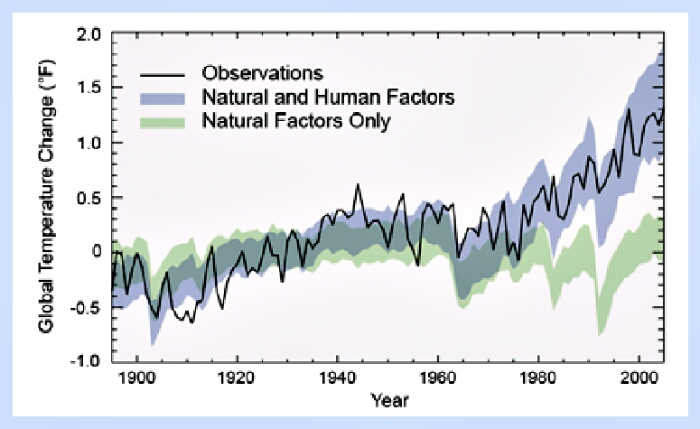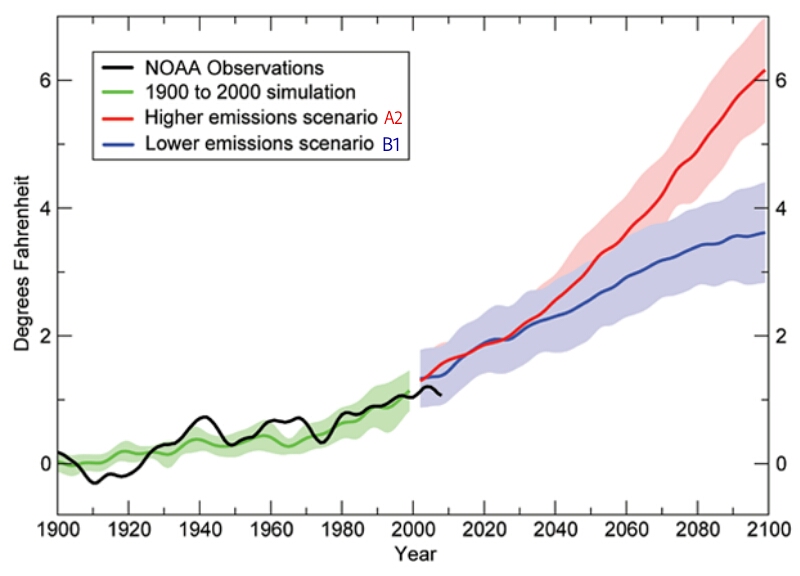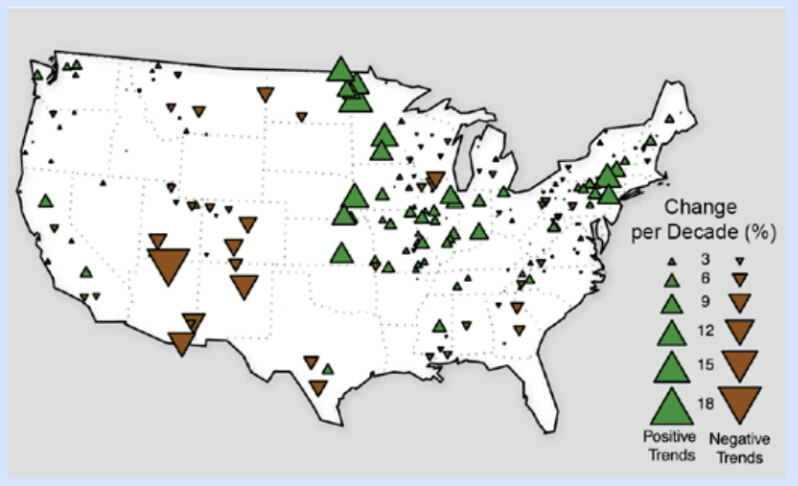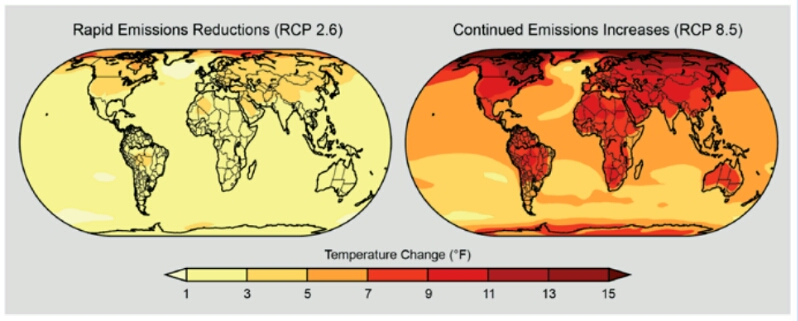With economic reports on the New Climate Economy being released every few days, we can rest assured that the new clean energy revolution is well underway. But, are you up to speed on the latest compilation of U.S. climate change facts? If not, or if you’d like a quick refresher, the article below is helpful. Composed of two parts, the first is entitled, Global Warming – Part I: Updated Climate Change Facts.
As required by the Global Change Research Act of 1990, the 2014 National Climate Assessment, Climate Change Impacts in the United States, was compiled from the accumulation of three years of data by a team of over 300 experts. Gleaned from the 2014 NCA, I originally wrote this article for readers of our faith-based environmental activism sister site, EdenKeeper.org, as a follow-up to a two-part series on fossil fuel divestment.
Global Warming – Part I: Updated Climate Change Facts
Our earth is a precious gift, a blessing of immeasurable value from a Generous Creator. It sings and sparkles to those with appreciative ears and eyes, and makes our hearts swell with spirituality. But this precious gift comes with a responsibility as caretakers, and for this we need to understand Earth’s condition — clearly and factually. Beyond the song and sparkling view is a foreboding threat of terrible danger.
Following up our series on Fossil Fuel Divestment for religious organizations, this series lays out the measurable facts of climate change. Armed with this diagnostic data, as caring stewards we are obligated to help alleviate the serious case of global warming from which our beloved Earth is suffering.
Research teams around the world analyze trends in temperature, precipitation, sea level, ice mass, and many other variables recorded by weather measuring systems. Undeniably, the sea level is rising, arctic sea ice and glaciers are melting, and oceans are becoming more acidic as they absorb carbon dioxide. Extreme weather events are occurring more frequently and intensely, such as droughts, lengthy hot spells, heavy downpours, and floods.
As we will see in this report, all of these conditions are due primarily to human activities related to burning fossil fuels, i.e., coal, oil, and gas. Part II: Mitigating The Damage will cover scenarios and recommendations to correct our current malpractices, and guide us to restore the health of our beautiful planet.
The 2014 National Climate Assessment Report
The report, Climate Change Impacts in the United States, was compiled from the accumulation of three years of data by a team of over 300 experts. As required by the Global Change Research Act of 1990, this third National Climate Assessment was overseen by a 60 member Federal Advisory Committee.
Public and private decision-makers at all levels can be better equipped with the results of this comprehensive assessment of climate change. Studying this report can help all of us see what is actually happening to us and our environment, and understand what global warming means for our lives, our livelihoods, and our future.
Report Confirms Human-Induced Climate Change
Natural factors like the sun and erupting volcanos are not responsible for the warming trend of the past 50 years. Satellite sensors in this period have found no overall increase in the sun’s output. Large volcanic eruptions, such as Mount Pinatubo in 1991, had a short cooling effect. In fact, slightly cooler global temperatures would actually have been the case if human activity had not been detrimentally affecting the climate of the past 50 years.
The buildup of heat-trapping, or “greenhouse” gases, is confirmed to be the greatest cause of climate change. Since the Industrial Revolution, the concentration of carbon dioxide in the atmosphere has increased by more than 40% due to emissions from burning fossil fuels. Scientists have understood for nearly 200 years that carbon dioxide traps heat. Methane and nitrous oxide emissions from agriculture and other human activities are also responsible for additional increases of heat-trapping gases.
The Realities of Global Warming
Climate change is negatively affecting every region of our country and impacting our entire economy. The rapidity of global heating is stressing our society and its infrastructure in ways we are not prepared for. It is critical that we understand these realities, as reported in the 2014 National Climate Assessment:
● The global warming of the past 50 years is primarily human-induced, due to the burning of fossil fuels.
Separating Human From Natural Influences On Climate
Image Notes: The green band shows changes over the last century due to natural forces alone, as simulated by climate models. The blue band shows model simulations of the effects of human and natural forces combined. The black line shows the actual observed global average temperatures. Only with the inclusion of human influences can models reproduce the observed temperature changes. (Source: adapted from Huber and Knutti 2012b)
● Heat-trapping gases already in the atmosphere have committed us to a hotter future with more climate-related impacts over the next few decades.
Future Climate Change Projected
Image Notes: Different amounts of human-induced, heat-trapping gases released into the atmosphere produce different projected increases in temperature. A2 assumes continued increases in emissions, and B1 assumes significant emissions reductions. (Source: NOAA NCDC / CICS-NC)
● Rising temperatures are already affecting societies and the environment across the nation. Children, the elderly, the sick, the poor, and nature are especially vulnerable.
Global Heating Observed In U.S. Temperature Changes
Image Notes: U.S. average temperature has increased by 1.3°F to 1.9°F since 1895; most increase occurred since 1970. The most recent decade was the warmest on record. Climates vary naturally, so rising temperatures are not evenly distributed across the country or over time.
● Over the last 50 years, much of the United States has seen an increase in prolonged periods of excessively high temperatures, heavier downpours, and in some regions, more severe droughts.
Observed Changes in Very Heavy Precipitation
Image Notes: Percent changes in the amount of precipitation falling in very heavy events (the heaviest 1%) from 1958 to 2012 for each region. There is a clear national trend toward a greater amount of precipitation being concentrated in very heavy events, particularly in the Northeast and Midwest. (Source: updated from Karl et al. 2009c )
● Damage to U.S. infrastructure includes roads, buildings, industrial facilities, ports and coastal military installations, rail lines, and airport runways, due to increasing heat, sea level rise, storm surge, and heavy downpours, and is projected to increase with continued climate change.
Trends in Flood Magnitude
Image Notes: Trend magnitude (triangle size) and direction (green = increasing trend, brown = decreasing trend) of annual flood magnitude from the 1920s through 2008. (Source: Peterson et al. 201348)
● Impacts on ecosystems and livelihoods pertaining to water supply reliability and quality from heavy flooding are expected to increase.
● Ocean waters are becoming warmer and more acidic, broadly affecting ocean circulation, chemistry, ecosystems, distribution, and abundance of marine life.
As Oceans Absorb CO2 They Become More Acidic
Image Notes: The correlation between rising levels of carbon dioxide in the atmosphere (red) with rising carbon dioxide levels (blue) and falling pH in the ocean (green). As carbon dioxide accumulates in the ocean, the water becomes more acidic (the pH declines). (Source: modified from Feely et al. 2009d)
● Ecosystems, such as forests, barrier beaches, and wetlands, and the biodiversity within them are being impacted, notably in the timing of critical biological events like spring budding, by extreme weather events, and substantial range shifting of many species.
● Extreme heat, drought, disease, and heavy downpours are causing increasing impacts on crops and livestock, possibly diminishing food supply security.
● Longer frost-free periods for plant growth can increase the growth of beneficial plants, as well as ragweed. Some fruit-bearing trees will be impacted by the loss of frost days. Also, increased heat and reduced moisture can lead to earlier and longer fire seasons.
Observed Increase in Frost-Free Season Length
Image Notes: The frost-free season length, defined as the period between the last occurrence of 32°F in the spring and the first occurrence of 32°F in the fall, has increased in each U.S. region during 1991-2012 relative to 1901-1960. (Source: NOAA NCDC / CICS-NC)
● Increased extreme weather events impact human health and well-being, especially threatening vulnerable populations. Fatalities and illness result from wildfire, decreased air quality, and diseases transmitted by insects, food, and water.
● Climate change impacts indigenous peoples’ health, well-being, and traditional ways of life, due to loss of ancestral homelands, traditional food supplies, decreased water quality, and increasing exposure to health and safety hazards.
● Actions to reduce emissions, increase carbon uptake, adapt to a changing climate, and increase resilience to impacts that are unavoidable can improve public health, economic development, ecosystem protection, and quality of life.
Projected Change in Average Annual Temperature
Image Notes: Projected change in average annual temperature over the period 2071-2099 (compared to the period 1970-1999) under a low scenario that assumes rapid reductions in emissions and concentrations of heat-trapping gases (RCP 2.6), and a higher scenario that assumes continued increases in emissions (RCP 8.5). (Source: NOAA NCDC / CICS-NC)
Responding to Climate Change
In the next few decades the choices we make about fossil fuel emissions will have an impact on the future rate of climate change. Lower emissions will reduce the speed and effects of climate change, but higher emissions will dangerously increase their magnitude. The primary focus of the National Climate Assessment Report is on the specific impacts of global heating in the United States. However, it also documents some steps society is taking or can take to reduce heat-trapping gas emissions and increase carbon dioxide removal from our atmosphere.
There are a variety of mitigating steps being studied to reduce the current rate of climate change. For example, steps in the right direction include strategies, technologies, and policies leading to more efficient production and increased use of fossil free energy sources, such as solar, wind and battery power, and also carbon capture and storage.
Many religious organizations have advocated for these mitigation steps. For example, religious organizations from different faiths and denominations have voiced their support for the Obama administration’s new carbon pollution rules. And the World Council of Churches and Religions for Peace are organizing an Interfaith Summit on Climate Change in New York City on September 21, 2014.
Global Warming – Part II: Mitigating The Damage will look deeper into the scenarios and recommendations offered in the third National Climate Assessment for repairing and healing our beautiful planet. With special care and attention from everyone, especially Earth’s faithful stewards, we can all pray for successful corrections and work together for a full recovery of sustainable health.
Keep up to date with all the eco-spirituality news here on EdenKeeper. Subscribe to our newsletter to never miss a story.
Note: This article appeared first on Edenkeeper.org


















